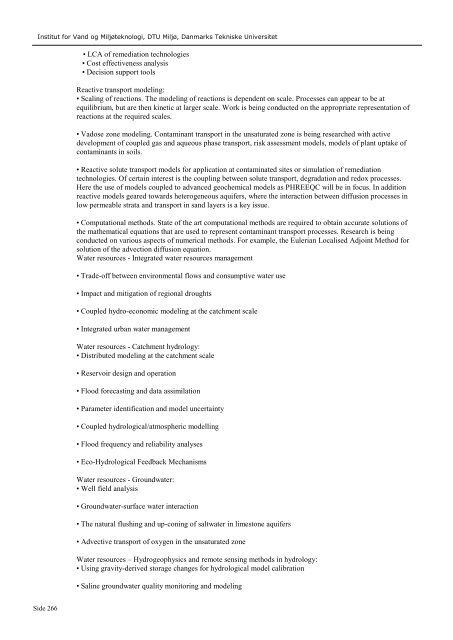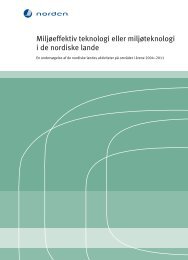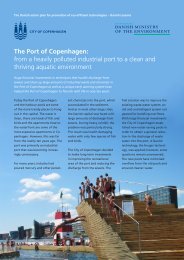- Page 1:
Vidensinstitutioner, miljøteknolog
- Page 5:
Forord Hensigten med dette katalog
- Page 8 and 9:
Under hver institution er der infor
- Page 11 and 12:
Katalog over institutioner: Afdelin
- Page 13 and 14:
Afdeling for Terrestrisk Økologi,
- Page 15 and 16:
Afdeling for Vildtbiologi og Biodiv
- Page 17 and 18:
Afdeling for Vildtbiologi og Biodiv
- Page 19 and 20:
Afdelingen for Brændselsceller og
- Page 21 and 22:
Afdelingen for Energi og Miljø, St
- Page 23 and 24:
Afdelingen for Energi og Miljø, St
- Page 25 and 26:
Afdelingen for Energi og Miljø, St
- Page 27 and 28:
AgroTech A/S afgasset biomasse. Yde
- Page 29 and 30:
Biologisk Institut, Det Naturvidens
- Page 31 and 32:
Biologisk Institut, Det Naturvidens
- Page 33 and 34:
Biologisk Institut, Det Naturvidens
- Page 35 and 36:
Biologisk Institut, Det Naturvidens
- Page 37 and 38:
Biologisk Institut, Det Naturvidens
- Page 39 and 40:
Center for Energi- og Miljøeffekti
- Page 41 and 42:
Center for Energi- og Miljøeffekti
- Page 43 and 44:
Center for Energi- og Miljøeffekti
- Page 45 and 46:
Danmarks Meteorologiske Institut (D
- Page 47 and 48:
Danmarks Meteorologiske Institut (D
- Page 49 and 50:
Danmarks Meteorologiske Institut (D
- Page 51 and 52:
Danmarks Meteorologiske Institut (D
- Page 53 and 54:
DHI afprøvning af miljøteknologie
- Page 55 and 56:
DHI Jette Bjerre Hansen Tlf.: +45 4
- Page 57 and 58:
DHI konkrete problemstillinger).
- Page 59 and 60:
DHI • Stormwater and Wastewater i
- Page 61 and 62:
DHI Detaljeret kendskabet til nedb
- Page 63 and 64:
DHI Beskrivelse af teknologier: •
- Page 65 and 66:
DHI Tlf.: +45 4516 9168 jt@dhigroup
- Page 67 and 68:
DHI • Det Strategiske forskningsr
- Page 69 and 70:
DHI Yderligere oplysninger Kenneth
- Page 71 and 72:
Divisionen for Energi, Klima og Mil
- Page 73 and 74:
Divisionen for Energi, Klima og Mil
- Page 75 and 76:
Divisionen for Energi, Klima og Mil
- Page 77 and 78:
Faggruppen for Afgrødevidenskab, I
- Page 79 and 80:
Faggruppen for Afgrødevidenskab, I
- Page 81 and 82:
Faggruppen for Afgrødevidenskab, I
- Page 83 and 84:
Faggruppen for Afgrødevidenskab, I
- Page 85 and 86:
Faggruppen for Afgrødevidenskab, I
- Page 87 and 88:
Fonden Dansk Standard Muligheder: Y
- Page 89 and 90:
Fonden Dansk Standard • Offentlig
- Page 91 and 92:
Fonden Dansk Standard analysemetode
- Page 93 and 94:
Fonden Dansk Standard Ressourceforb
- Page 95 and 96:
Fonden Dansk Standard dog meget lav
- Page 97 and 98:
Forskergruppe Vandressourcer, HOBE
- Page 99 and 100:
Forskergruppe Vandressourcer, HOBE
- Page 101 and 102:
Geokemisk og Hydrologisk afdelinger
- Page 103 and 104:
Geokemisk og Hydrologisk afdelinger
- Page 105 and 106:
Geokemisk og Hydrologisk afdelinger
- Page 107 and 108:
Geokemisk og Hydrologisk afdelinger
- Page 109 and 110:
Geologisk Institut, Det Naturvidens
- Page 111 and 112:
Geologisk Institut, Det Naturvidens
- Page 113 and 114:
Innovationsnetværket for Biomasse,
- Page 115 and 116:
Innovationsnetværket for Biomasse,
- Page 117 and 118:
Innovationsnetværket for Biomasse,
- Page 119 and 120:
Innovationsnetværket for Biomasse,
- Page 121 and 122:
Institut for Akvatiske Ressourcer,
- Page 123 and 124:
Institut for Akvatiske Ressourcer,
- Page 125 and 126:
Institut for Akvatiske Ressourcer,
- Page 127 and 128:
Institut for Akvatiske Ressourcer,
- Page 129 and 130:
Institut for Bioscience, Det Nation
- Page 131 and 132:
Institut for Bioscience, Det Nation
- Page 133 and 134:
Institut for Bioscience, Det Nation
- Page 135 and 136:
Institut for Biosystemteknologi, De
- Page 137 and 138:
Institut for Biosystemteknologi, De
- Page 139 and 140:
Institut for Byggeri og Anlæg, Det
- Page 141 and 142:
Institut for Byggeri og Anlæg, Det
- Page 143 and 144:
Institut for Byggeri og Anlæg, DTU
- Page 145 and 146:
Institut for Byggeri og Anlæg, DTU
- Page 147 and 148:
Institut for Byggeri og Anlæg, DTU
- Page 149 and 150:
Institut for Byggeri og Anlæg, DTU
- Page 151 and 152:
Institut for Fysik og kemi, Det Nat
- Page 153 and 154:
Institut for Fysik og kemi, Det Nat
- Page 155 and 156:
Institut for Genetik og Bioteknolog
- Page 157 and 158:
Institut for Genetik og Bioteknolog
- Page 159 and 160:
Institut for Genetik og Bioteknolog
- Page 161 and 162:
Institut for Genetik og Bioteknolog
- Page 163 and 164:
Institut for Grundvidenskab og Milj
- Page 165 and 166:
Institut for Grundvidenskab og Milj
- Page 167 and 168:
Institut for Grundvidenskab og Milj
- Page 169 and 170:
Institut for Grundvidenskab og Milj
- Page 171 and 172:
Institut for Havebrugsproduktion, D
- Page 173 and 174:
Institut for Havebrugsproduktion, D
- Page 175 and 176:
Institut for Havebrugsproduktion, D
- Page 177 and 178:
Institut for Havebrugsproduktion, D
- Page 179 and 180:
Institut for Husdyrbiologi og -sund
- Page 181 and 182:
Institut for Husdyrbiologi og -sund
- Page 183 and 184:
Institut for Husdyrbiologi og -sund
- Page 185 and 186:
Institut for Husdyrbiologi og -sund
- Page 187 and 188:
Institut for Husdyrbiologi og -sund
- Page 189 and 190:
Institut for Jordbrug og Økologi,
- Page 191 and 192:
Institut for Jordbrug og Økologi,
- Page 193 and 194:
Institut for Jordbrugsproduktion og
- Page 195 and 196:
Institut for Jordbrugsproduktion og
- Page 197 and 198:
Institut for Jordbrugsproduktion og
- Page 199 and 200:
Institut for Kemi-, Bio- og Miljøt
- Page 201 and 202:
Institut for Kemi-, Bio- og Miljøt
- Page 203 and 204:
Institut for Kemi-, Bio- og Miljøt
- Page 205 and 206:
Institut for Kemi-, Bio- og Miljøt
- Page 207 and 208:
Institut for Kemi-, Bio- og Miljøt
- Page 209 and 210:
Institut for kemi, DTU Kemi, Danmar
- Page 211 and 212:
Institut for kemi, DTU Kemi, Danmar
- Page 213 and 214:
Institut for kemi, DTU Kemi, Danmar
- Page 215 and 216: Institut for Kemi, Miljø og Biotek
- Page 217 and 218: Institut for Kemi, Miljø og Biotek
- Page 219 and 220: Institut for Kemi, Miljø og Biotek
- Page 221 and 222: Institut for Kemi, Miljø og Biotek
- Page 223 and 224: Institut for Kemiteknik, DTU Kemite
- Page 225 and 226: Institut for Kemiteknik, DTU Kemite
- Page 227 and 228: Institut for Kemiteknik, DTU Kemite
- Page 229 and 230: Institut for Kemiteknik, DTU Kemite
- Page 231 and 232: Institut for Miljø, Samfund og Rum
- Page 233 and 234: Institut for Miljø, Samfund og Rum
- Page 235 and 236: Institut for Miljø, Samfund og Rum
- Page 237 and 238: Institut for Miljøvidenskab, DMU,
- Page 239 and 240: Institut for Miljøvidenskab, DMU,
- Page 241 and 242: Institut for Miljøvidenskab, DMU,
- Page 243 and 244: Institut for Miljøvidenskab, DMU,
- Page 245 and 246: Institut for Natur, Systemer og Mod
- Page 247 and 248: Institut for Natur, Systemer og Mod
- Page 249 and 250: Institut for Plantebeskyttelse og S
- Page 251 and 252: Institut for Plantebeskyttelse og S
- Page 253 and 254: Institut for Teknologi og Innovatio
- Page 255 and 256: Institut for Teknologi og Innovatio
- Page 257 and 258: Institut for Teknologi og Innovatio
- Page 259 and 260: Institut for transport, DTU Transpo
- Page 261 and 262: Institut for Vand og Miljøteknolog
- Page 263 and 264: Institut for Vand og Miljøteknolog
- Page 265: Institut for Vand og Miljøteknolog
- Page 269 and 270: Institut for Vand og Miljøteknolog
- Page 271 and 272: Institut for Vand og Miljøteknolog
- Page 273 and 274: Institut for Vand og Miljøteknolog
- Page 275 and 276: Institut for Vand og Miljøteknolog
- Page 277 and 278: LCA Center Danmark LCA Center Danma
- Page 279 and 280: LCA Center Danmark Kontaktpersoner:
- Page 281 and 282: LCA Center Danmark Eventuelle links
- Page 283 and 284: LCA Center Danmark Forskningsmæssi
- Page 285 and 286: Nationallaboratoriet for Bæredygti
- Page 287 and 288: Nationallaboratoriet for Bæredygti
- Page 289 and 290: Nationallaboratoriet for Bæredygti
- Page 291 and 292: Nationallaboratoriet for Bæredygti
- Page 293 and 294: Skov & Landskab, Det Biovidenskabel
- Page 295 and 296: Skov & Landskab, Det Biovidenskabel
- Page 297 and 298: Teknologisk Institut Teknologisk In
- Page 299 and 300: Teknologisk Institut Andre oplysnin
- Page 301 and 302: Teknologisk Institut trine.damgaard
- Page 303 and 304: Teknologisk Institut Tlf.: +45 7220
- Page 305 and 306: Teknologisk Institut Online måling
- Page 307 and 308: Teknologisk Institut Claus Scøn Po
- Page 309 and 310: Teknologisk Institut Yderligere opl
- Page 311: Teknologisk Institut 2) Medvirken i




